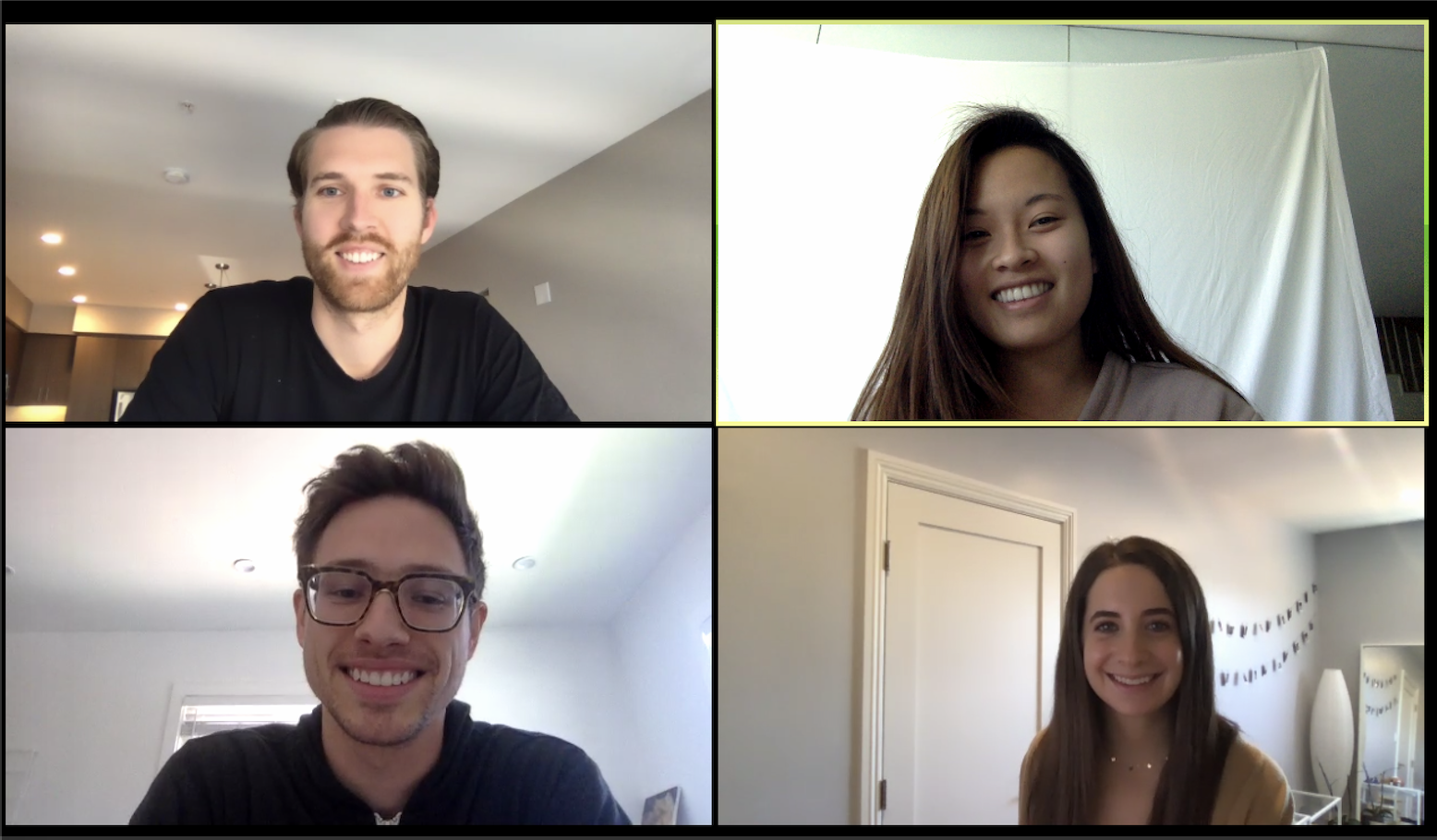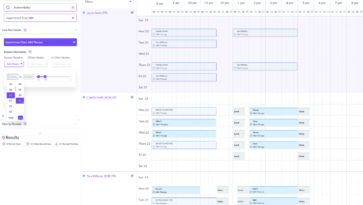
During these unprecedented times… just kidding. I don’t want to read another one of those articles either. Instead of dwelling on how weird the last 10 weeks have been, I wanted to mention that the team at Sidebench is feeling pretty grateful these days. We’ve learned a lot while shifting to entirely remote collaboration, installing a lot of good things that can be put to good use when we get back to the office, but it’s not to say we haven’t faced some challenges along the way.
One of those challenges is a really fortunate “problem” to have right now — over the last 10 weeks we’ve added 4 new team members to the roster, and we’ll have a 5th joining us next week. Onboarding itself is always a bit of a moving target, but toss in the fact that we’re all working from home and the challenge grows taller.
The biggest takeaway while onboarding new team members remotely is that it presents a lot of unique hurdles, but it’s also presenting a lot of new opportunities for us. It’s forced us to re-evaluate onboarding entirely, and we’ve done a good job utilizing new tools and processes with our new hires. Some of the things we’ve put a lot of emphasis on:
- Reviewing our current set of tools to identify what we should add, subtract, or augment
- Piloting a platform called Trainual to act as a self-service, easy-to-reference onboarding guide
- Adding more face to face meetings and quick team-centric syncs via video call
- Re-focusing our efforts on thoughtfully designing 30, 60, and 90 day goals while utilizing OKRs
- Remembering that when we onboard someone right now that they are in a big transition during a strange time and doing our best to remain sensitive to that by not expecting them to hit their full-stride right away
Like I said, the work on improving onboarding comes with lots of ups and downs, but we feel like we’ve been testing and validating these new practices in a way that will only improve our new hire experiences for the long haul. In the same way that developing products requires real user feedback to build the best possible experiences, I thought it would be great to hear from our new teammates about how it went so that we can continue to evolve the process, and I thought you guys might like to learn from them as well.
Q+A
(More info about the interviewees can be found at the end of this article)
Tell me about your onboarding process with Sidebench so far.
Michael Farmer, Product Generalist: As I’ve said a few times before, onboarding at Sidebench is like jumping onto a moving train. You have to master Sidebench policies, client project intricacies, and an agency lexicon all at the same time. Oh, and by the way, you’re quarantined! Luckily, the team at Sidebench is always available to support you while forming your Sidebench brain. All questions are welcome and there’s always time to meet 1 on 1. That culture has been the key to my success.
Katja Max, Associate Product Manager: Onboarding has mostly consisted of various meetings with other team members I will be working with. It has been a great way to not only understand the PM relationship with those individuals but also get to know them. Other than that, it has been a lot of Slack message questions back and forth.
Emily Chen, Marketing Apprentice: Onboarding with Sidebench virtually was a unique experience. Being able to hop on an informal Zoom call with each team during my first week helped me understand the organization structure and how my role fits within the company. In terms of getting up to speed on company basics, Trainual was a good starting point for learning about the company mission and Sidebench’s services.
How has onboarding during quarantine been as compared to other onboarding processes you’ve been through before?
MF: From my first day, the pace has been very quick. I think I probably jumped into more complex client-facing work a bit sooner than at other jobs I’ve had, because people were able to primarily focus on my deliverables. I’m not interfacing with my teammates at all times, because we’re not in the same workspace. So, what I produce becomes representative of where I should be in the onboarding process.
Adam Bedford, Director, Solutions Architecture: Joining Sidebench has actually been more structured than any previous onboarding, in spite of the obstacles that a temporarily all-remote team might experience.
KM: It feels as though there are more missing pieces during quarantine. There is definitely more downtime in between scheduled meetings, that had I been in an office would probably be spent shadowing and getting pulled into meetings to gain context. That being said, having some more alone time to digest information and get ramped up has made it feel less like drinking from a firehose than other onboarding processes I’ve experienced.
EC: Onboarding remotely has been surprisingly similar to other onboarding processes I’ve experienced in person. A lot of the processes I’m used to, such as meeting the teams and reviewing documentation, were almost identical to how I’ve experienced onboarding previously.
What has been the most unique thing about onboarding during quarantine?
MF: I’ve had more meetings aimed at making sure I feel supported than I ever did while working in an in-person environment.
AB: Such a strong focus on defining OKRs so early on. There’s more structure on that front but it does help prioritize tasks and actions
KM: Having no idea what the office looks like or feels like. I think you can learn so much about a company by the office and the people who happen to be there when you visit and arrive for your first day. Not having that aspect made both the recruiting and onboarding aspect much more challenging.
EC: What’s been unique about onboarding during quarantine is the extra touches that HR has put in to make new employees feel welcome, even while working from home. For example, the funny (embarrassing) slide that was included during the All-Hands meeting came as a pleasant surprise.
What’s the biggest hurdle of onboarding remotely as opposed to within an office?
AB: Missed ad-hoc interactions that can spur meaningful conversations.
KM: You don’t naturally bond with the team as much as you would in person. There are no lunchtime conversations, desk chats, etc. and so the bonding moments have to be more structured. There are also a lot of systems that the company uses, and getting up to speed on what lives where, and is used for what has been tough.
EC: The biggest hurdle would definitely be trying to understand how different teams work together. In the office, it’s easier to observe how work flows between different employees. Being able to see how other employees interact with each other is something I miss from being in the office.
What have been the most helpful pieces of the onboarding process thus far?
MF: The people at Sidebench. They are what helped me to be successful.
AB: Intro meetings. Filling my calendar with the recurring meetings from Day 1 helped me get a clearer picture of the weekly rhythm.
KM: Having Trainual as a reference has been especially helpful. Being able to easily access and reference a variety of things that would often become tribal knowledge at a different company has been extremely helpful.
EC: Having a 30/60/90 day plan was helpful and consistent check-ins with my direct supervisor.
What have been the most helpful meetings set up for you during onboarding?
MF: Project-specific stand up meetings have been the most helpful, because they help me be doubly sure that what I’m working on is the most impactful to the team.
KM: Going over some frameworks with Spencer was especially helpful. Getting some insight into what a PM does/doesn’t do, how to lead the discovery process, etc has really solidified a lot of the questions I have. Meeting with my first client also answered a lot of outstanding questions.
EC: During onboarding, weekly marketing syncs were helpful, while meetings with HR to set goals was helpful for tracking my progress.
How has it been getting to know people? What’s been working for you?
MF: It has been great, though I think that’s a product of Sidebench having great people. If you’re having an internal meeting, I recommend asking your teammates how they are doing at the beginning of the meeting. People normally answer openly and it helps everyone to feel heard and more connected.
AB: I’ve made it a priority to schedule quick sync meetings with a handful of people in an effort to replace the impromptu in-office discussions. Naturally, it helps to get to know folks outside the context of a particular meeting or Sidebench in general and this has been somewhat effective for that purpose.
KM: Having 1:1s with people has been helpful! Sometimes it feels very natural to chat with someone about themselves and their role as Sidebench, and other times that chemistry just doesn’t transfer over video and it feels more like an awkward first date. I think that is all part of the process, but I am looking forward to the day where we do get to meet in person!
EC: It has been difficult getting to know people remotely, especially for those team members who don’t work directly with marketing. What’s worked for me being able to work with people on projects related to marketing and getting to know them that way.
If you had to give advice to companies onboarding during quarantine, what would you tell them?
MF: Make sure to coach employees on how to structure and run digital meetings, since that’s how all of your meetings are going to occur! For me, a key component of digital meetings are incorporating ice breakers. They help meeting participants shake off any quarantine-related blues or disconnectedness.
AB: Do it. Keep hiring when possible. Remote onboarding is very possible, as evidenced by the growing number of remote-only companies. The process breaks down when a company is only partly remote and those not in the office suffer. In the case of Covid, we’ve been forced to go all remote so this doesn’t really apply.
KM: Setting up a lot of meetings with teammates and other coworkers is crucial. Not only do you give people the opportunity to see where their new position fits into the larger company, but having some face time with someone makes reaching out to them for questions feel more comfortable and welcoming. Also, try to provide higher level overviews before diving into details. A lot of the high-level understanding comes more naturally in an office-setting and trying to back into it from details can be tough and confusing while remote.
EC: Do your best to make your new employees feel welcome and part of the team. It can feel pretty isolating to start with a new team remotely, but HR can step in to make the transition smoother.
If you had to give advice to new employees who are onboarding during quarantine, what would you suggest?
MF: Ask all the questions. Your teammates want you to reach out to them. They think you’re great.
AB: It’s not going to be exactly the same as the first weeks in the office but it can come close. When we do return to the office, I suggest taking some time to get to know people face-to-face as if it was during onboarding. It’ll be too easy to return to the office and continue with the work routine that was established remotely.
KM: Ask a lot of questions! Everyone seems very willing to answer them (at least so far!)
EC: Don’t be afraid to voice your questions and concerns.
In Conclusion
To wrap things up, onboarding while remote is not a walk in the park, but it is a really great learning experience and has provided a ton of strong team building moments for us. It’s a unique opportunity for all of us to learn and grow together as we navigate one of the trickiest parts of hiring.
For what it’s worth, here are my 2 cents:
If you’re looking for a new role right now and anxious about what remote onboarding holds, think hard about what would make you feel comfortable over the first few weeks and don’t be afraid to ask for it. Push leaders at your new company to provide thorough learning materials, put you in touch with common collaborators, and please speak up and ask questions at every turn — we’re here to help!
If you’re an employer, embrace the challenge and embrace the concept of servant leadership. Yes, onboarding right now isn’t easy, but is it ever? Right now presents a cool opportunity to create strong bonds with new team members as you work with them to navigate ambiguity and solve problems as a team. Crushing your “first impression” will build confidence and trust in your employer:employee relationship for years to come.
At the end of the day, we’re grateful for all we’ve learned during quarantine, and onboarding has certainly fast-tracked some of the most exciting changes we’ve made re: hiring at Sidebench over the last few years. We’re looking forward to what’s ahead, and we’re looking to figure it out, together.
Get to Know the Interviewees
A brief “who’s who” of our employees that are helping us re-invent onboarding at Sidebench:
We hired Emily Chen as our new Marketing Apprentice right before the stay at home orders went into place. Emily recently graduated from UCLA. What an incredible time to have her first job out of school! Her first day was unexpectedly remote.
Later in March, we added Michael Farmer as a Product Generalist, who moved from Richmond, VA to join us here in LA. Michael navigated a cross country road trip with his girlfriend and dog right as lockdowns were going into effect across the country. What a journey!
In April, we added Adam Bedford who joined as Director, Solutions Architecture. Adam joins us with a seasoned background as a serial entrepreneur and brings both a wonderful English accent and a deep wealth of technical expertise.
Most recently, we added Katja Max as an Associate Product Manager. Katja is a Bird alumnus, who’s bringing her mobility and strategy experience to the team.
The four of them have been crushing it so far, and if you have any questions about onboarding at Sidebench, feel free to connect with us on LinkedIn or elsewhere!







